The Crucial MX300 750GB SSD Review: Micron's 3D NAND Arrives
by Billy Tallis on June 14, 2016 9:00 AM ESTSequential Read Performance
The sequential read test requests 128kB blocks and tests queue depths ranging from 1 to 32. The queue depth is doubled every three minutes, for a total test duration of 18 minutes. The test spans the entire drive, and the drive is filled before the test begins. The primary score we report is an average of performances at queue depths 1, 2 and 4, as client usage typically consists mostly of low queue depth operations.
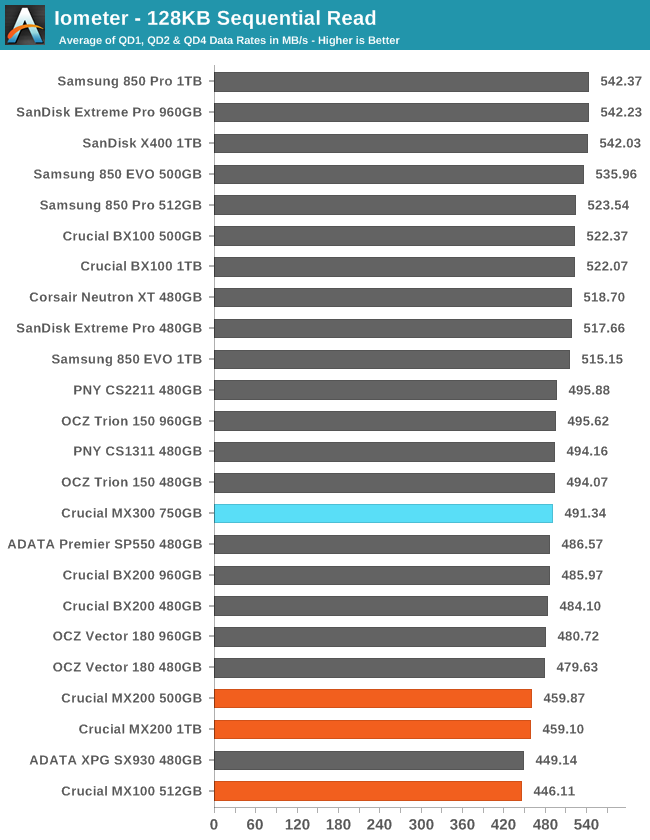
The earlier MX series drives had somewhat poor sequential read speeds, though the spread from best to worst is quite small. The MX300 brings things up to average.
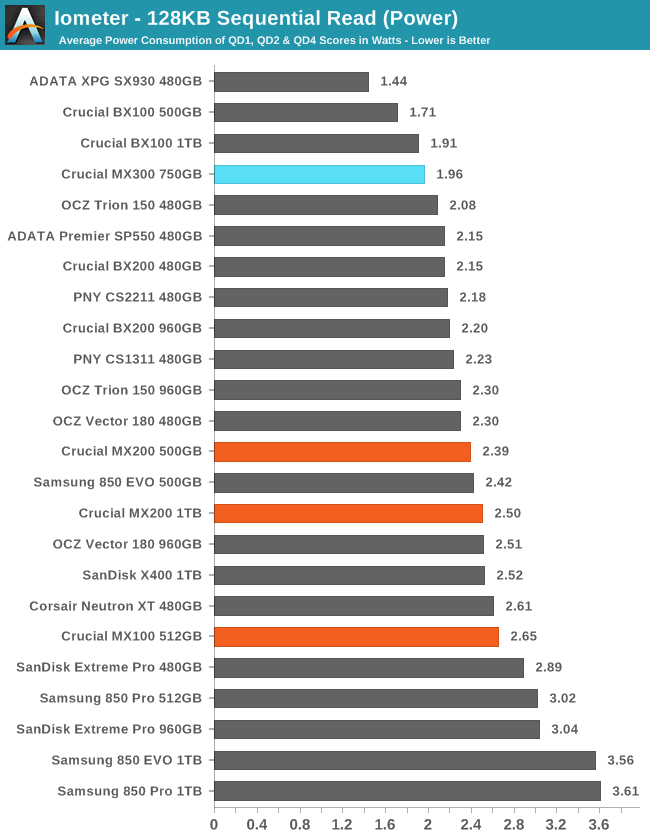
The MX300 is still quite efficient, but the SX930 and BX100 500GB both beat it by a wide margin.
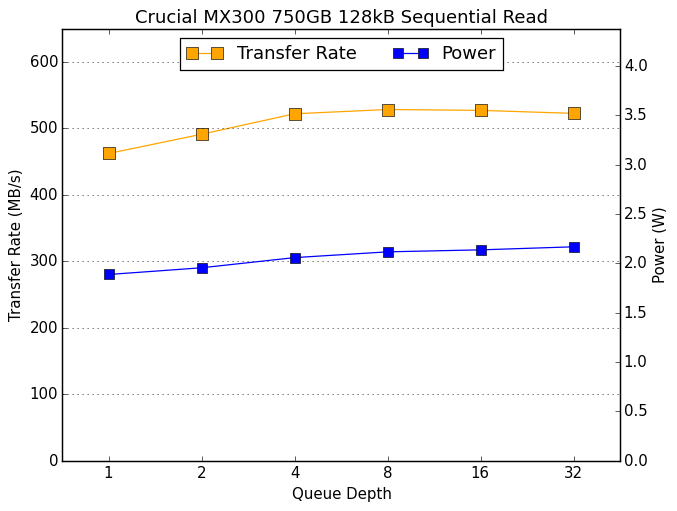 |
|||||||||
With a higher starting point, the MX300's performance scaling is not as pronounced as the MX200's. The MX300 is a little bit slower at higher queue depths.
Sequential Write Performance
The sequential write test writes 128kB blocks and tests queue depths ranging from 1 to 32. The queue depth is doubled every three minutes, for a total test duration of 18 minutes. The test spans the entire drive, and the drive is filled before the test begins. The primary score we report is an average of performances at queue depths 1, 2 and 4, as client usage typically consists mostly of low queue depth operations.

Sequential write speeds on the MX300 are much slower than the MX200 or any other MLC drive, but it does manage to come out ahead of all the planar TLC drives.
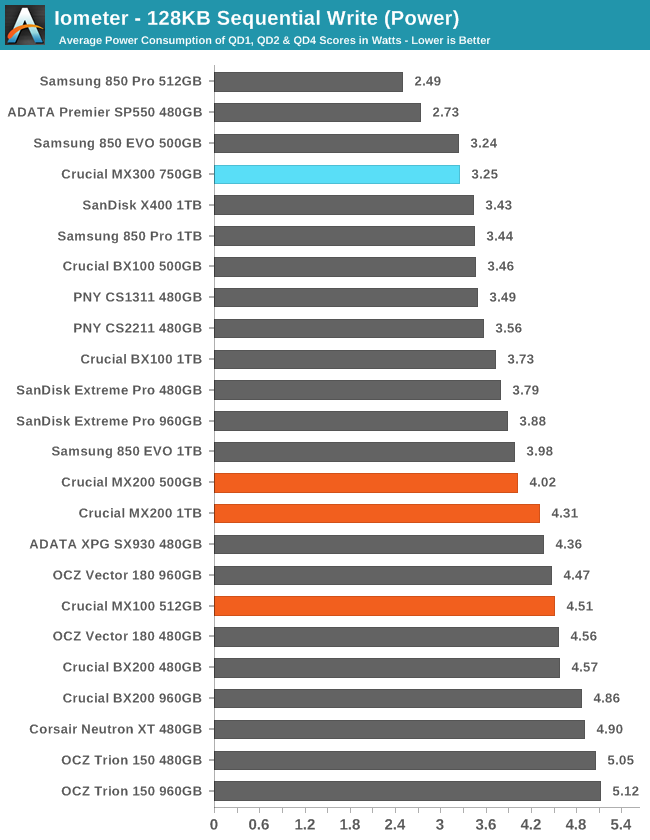
Power efficiency is still great by planar TLC standards, but the Samsung 850 EVO managed to saturate the SATA connection while using the same amount of power.
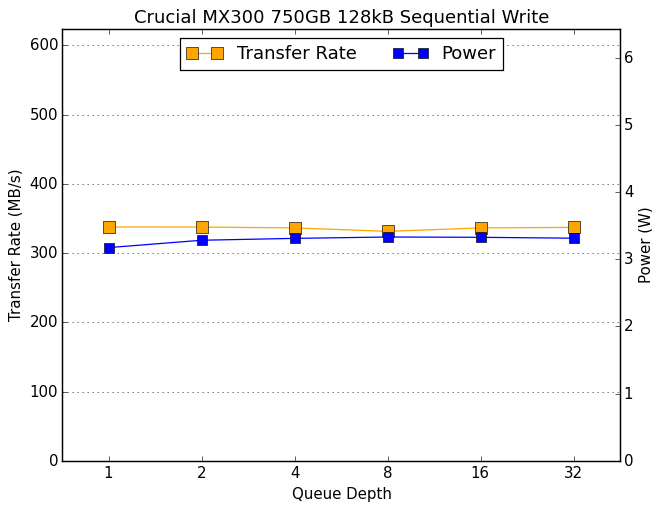 |
|||||||||
The MX300 shows essentially no scaling with queue depth. For this test we usually don't see much scaling as caching large writes allows for full performance even at low queue depths, but full performance for the MX300 is still disappointing.










85 Comments
View All Comments
euskalzabe - Sunday, June 19, 2016 - link
Excellent reply, bravo.tonyman - Thursday, June 23, 2016 - link
To refute your point that "Nobody Uses SSDs for Cold Storage", I'll give a real-world counterexample... I make a machine vision system that I sell into a factory environment. I build the PCs that the system runs on, and sell it as a turnkey system. For reliability and performance, these PCs are equipped with SSDs as their boot and data drives. As this system, and therefore the PC it runs on, is mission critical, many customers purchase extra preconfigured PCs from us... which can sit around for several years before being used. Data retention on the boot drives of these cold-stored PCs is therefore quite a big issue... one I was ignorant of until a year or so ago, unfortunately. Oops.JKJK - Thursday, June 23, 2016 - link
Raid 0 for storage?Russian rulette ... catch you on the flipside.
sor - Tuesday, June 14, 2016 - link
The MX300 had best in class mixed read/write power performance, and close to the best in other power benchmarks. It seems to beat it's primary competitors (< $.30/GB) on performance, like the OCZ Trion. It could be a better value to make it an obvious buy, but it seems fair to me. It costs less and performs worse than the > $.30/gb range and costs more and performs better than the < $.25/GB.barleyguy - Tuesday, June 14, 2016 - link
"uses more power" isn't accurate. The power usage under load is flat out excellent.Byte - Tuesday, June 14, 2016 - link
Pricing average for 1TB(960GB) is about $200 (you can get ocz trion or silicon power at this price point every day, they are decent mainstream SSDs). This would need to be $150 to even be worth considering. If this had better performance maybe I can see it being worth more. I used a ton of Crucial SSDs and they are fine, but so are pretty much all the other brands i've used. I've only had 1 sandisk low end SSD die on me, and i've handled a few hundred.Gondalf - Wednesday, June 15, 2016 - link
Techreport (and Anandtech) say the contrary and i think they are a lot more reliable than you like hardware testers.TheinsanegamerN - Tuesday, June 14, 2016 - link
More power hungry, worse endurance, slower, and more expensive then the competition. Truly an amazing drive ! /sJoeyJoJo123 - Tuesday, June 14, 2016 - link
Oh no! Less SSD endurance! My current SSD gets winded after only 30 seconds of running! Whatever shall I do with typical consumer I/O workloads and less "endurance"!?[/sarcasm]kyuu - Tuesday, June 14, 2016 - link
Do people even read the article before posting negative crap anymore?It's not more power hungry. In fact, the article shows that it's quite power efficient.
I also hope you're not seriously comparing the MSRP of this drive versus the street prices of other drives. Street prices are always lower than the MSRP, especially in the SSD market.